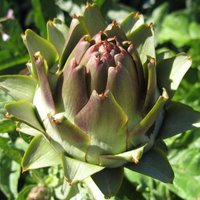Home › Home vegetable garden › Growing artichokes
Growing Artichokes:
Gourmet Vegetables for Beginners!

Growing artichokes is very easy which is surprising given that they are such a delicacy and very expensive to buy at the greengrocers.
I always think there is something totally decadent about sharing a dish of globe artichokes with friends - served, of course, with generous helpings of melted butter!
So what are artichokes? The globe artichoke (Cynara scolymus) is a member of the Compositae, the Daisy family, and is a type of giant thistle.
The part we usually eat is the immature flower bud although all parts of the plant are edible including the leaves and stems. Just a few plants should provide enough artichokes for the average family.
But artichokes are not only useful for culinary purposes.
They are also highly ornamental, growing into fabulously architectural thistle-like plants, up to 1.5m (5ft) high, with jagged silvery leaves.
They make a dramatic addition to your flower border if you're short of space in your vegetable patch.
If you don't pick the buds they develop into large violet flowers that attract bees into your garden, and are also very useful, either fresh or dried, for flower arrangements.
The globe artichoke is a real multi-purpose plant.
Where will They Grow?
Artichokes are adapted to mild coastal climates and don't appreciate extremes of heat and cold. In the right climatic conditions globe artichokes are perennial, and will live and produce crops for several years before they need replacing.
They are not fully frost hardy and in the colder parts of the UK will require some winter protection.
In the US they are suitable for growing in USDA Zones 7-10 but again may need protection if winter temperatures fall much below freezing for extended periods.
The information below explains about growing artichokes as perennials which is very straightforward. If you live in a region where heavy winter frosts are the norm, you may still be able to grow globe artichokes as annuals.
Soil and Situation
The key to success is growing artichoke plants in a warm, sheltered spot in full sun.
The best soil for growing artichokes is fertile and well drained, preferably with a neutral pH.
If you have sandy soil add lots of well rotted garden compost or manure to increase the nutrient content and improve the texture and moisture holding properties.
For poorly drained clay-based soils add some grit to improve drainage.
(For more information on soils see improving garden soil).
Artichokes also do well in established 'no dig' vegetable garden beds and in raised beds.
Should You Grow from Seed or Buy Young Plants?
Seed
Growing artichokes from seed is easy but quite often the seedlings do not all come true to type and you will need to grow more plants than needed to compensate for this.
You will not always be able to tell which are the 'duds' until they have matured... on the other hand this variation means there is always the possibility that you may turn up a new variety!
Young plants
The easiest way of growing artichokes is to buy them as young plants. As artichokes grow they produce offshoots or 'suckers' that can be removed from the parent plant and grown on. These offshoots are potted up for sale in nurseries and garden centres.
Buy offshoots of a named variety from a reputable supplier. It can be more expensive than buying seed but, as you will only need a few plants, it shouldn't break the bank.
In fact, if you know someone who is already growing artichokes you may be able to get the offshoots for nothing.
When and How to Sow or Plant
Sowing seed
Seeds can be sown either under cover or outdoors in March and April. If you are confident that the weather has warmed up and there will be no more frosts, sow the seeds outside in a seed bed.
Otherwise they are best sown in 9cm pots of good quality compost with some added grit or vermiculite to ensure good drainage.
Place the pots in a greenhouse, conservatory or even on a windowsill indoors to kickstart germination which will take around two to three weeks - so be patient.
Keep the compost evenly moist, and once the seedlings have become established, harden them off before planting in their cropping positions. Water them in well and apply a good layer of mulch around each plant.
Young plants
If you have bought young artichoke plants, they can be planted out in their cropping positions in April or May once all danger of frost has passed.
Each plant will need a good square metre/yard of growing space. Water them in well and then apply a generous mulch of well rotted garden compost.
Routine Care
Globe artichokes grown as perennials require very little maintenance and they can be treated like any other herbaceous perennials.
The most important task is to water them in dry spells, and particularly when the flower buds are forming.
They should also be kept weed free - this shouldn't be too much of a problem if you keep them well mulched.
Snip off any buds that develop in the first year so that the plant directs its energy into making good growth and developing a healthy root system. It often goes against the grain to do this but the plants will be more productive in the second and subsequent seasons if you do!
Cut the stems back to about 25cm (10in) after harvesting.
In colder regions apply winter protection. Artichokes like to be kept frost free and dry so I like to cover mine with twiggy brushwood and then heap dry leaves and straw on top. The brushwood stops the mulch from packing down into a cold soggy mass.
Plan ahead. Artichokes are most productive in years two to four and then start to decline so in the third year remove some of the offshoots that have formed around the parent plant and grow them on.
This is very easy to do and is just the same as dividing perennials. Wait until the leaves of the offshoot are a few inches high and then sever it from the parent plant using a sharp knife. Make sure that each offshoot has a decent section of root. The offshoots can either be potted up and grown on for a year, or planted out directly.
When and How to Harvest
Depending on the variety you are growing, artichokes can be harvested throughout the summer.
Allow the buds to swell and then pick them before the bottom scales start to splay outwards. Use a sharp knife to cut through the stem a couple of inches below the bud.
Harvest the main heads first to encourage the production of secondary buds.
Pests and Diseases
Globe artichokes are usually fairly trouble free.
Blackfly sometimes attack the developing buds and should be wiped off with a damp cloth as soon as you spot them.
Slugs and snails may also attack the young foliage so set up some beer traps nearby to catch them.
For More Information...
More information on vegetable growing can be found at creating a successful home vegetable garden.
If you're new to vegetable gardening, do try these other easy vegetables to grow.
Another vegetable that is in the gourmet league is sprouting broccoli. It is delicious, nutritious and very easy to grow. Growing broccoli gives you all the information you need.
Home › Home vegetable garden › Growing artichokes
